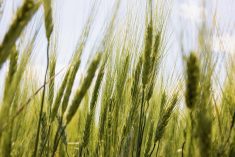A few pages from now you’ll see Jim Timlick check in on the topic of grain storage with Dr. Digvir Jayas, one of the Prairies’ best known experts in that field of research. Earlier this summer Dr. Jayas was named the president of the University of Lethbridge, after a storied 38-year stint at the University of Manitoba.
Not long before heading (further) west, Dr. Jayas conducted a study using the famous Canadian Light Source synchrotron at the University of Saskatchewan to look for some very, very, very subtle differences between varieties of durum.
Read Also

Conagra considers selling its share in Ardent Mills
Conagra is open to selling its 44 per cent share in Ardent Mills, North America’s largest milling company.
The Light Source has been used before to look at different wheats for fusarium resistance, and for how they change under fungal damage — but this study is meant to show which varieties of durum are more likely to take a hit in nutritional value due to spoilage in storage over time. As you can imagine, variations in wheat protein would be a big deal for durum end-users.
With the Light Source, the study looked at CDC Defy, AAC Stronghold and AAC Spitfire for changes in nutritional distributions, at the micron scale, following storage at “unsafe” moisture levels. It found Defy and Spitfire showed more deterioration than Stronghold. It also found all three varieties could be characterized based on how their nutrient content and distribution varied with spoilage and with time in storage.
Of course, it’s not like this was a contest. It was meant to show how the wheat seeds’ nutritional contents would behave — and where in the seeds they would change — under spoilage pressure in storage. And the researchers were working with the hypothesis that the durums would also behave differently by variety, which they did.
Dr. Jayas and the Light Source researchers also said this type of data could be helpful when making storage decisions — and the methodology of the study itself could also be helpful in looking at other Canadian wheat classes during storage. And this sort of information may also be useful to plant breeders in developing spoilage-resistant varieties that hold onto their nutritional content longer. — D.B.















